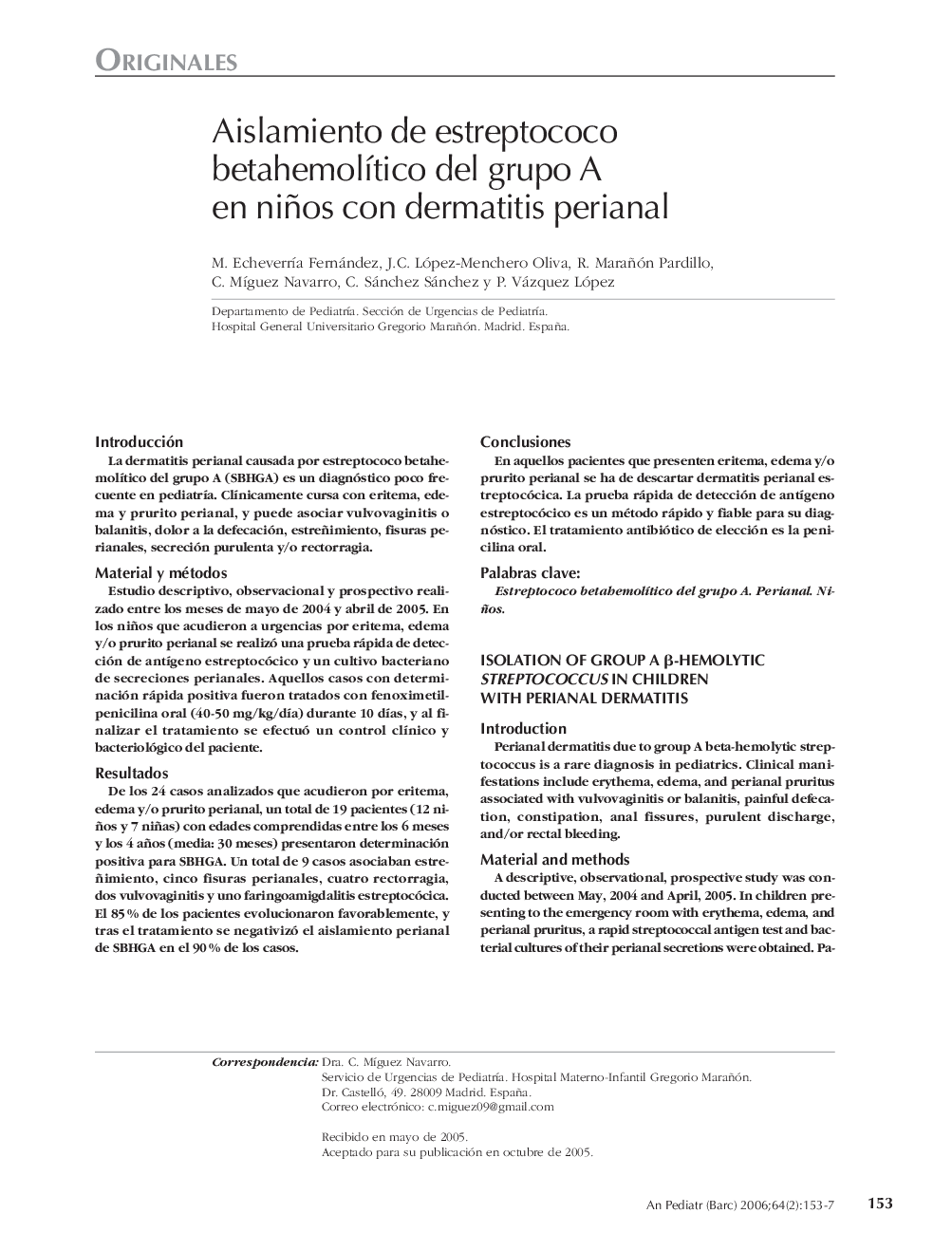| کد مقاله | کد نشریه | سال انتشار | مقاله انگلیسی | نسخه تمام متن |
|---|---|---|---|---|
| 4143913 | 1272426 | 2006 | 5 صفحه PDF | دانلود رایگان |

IntroducciónLa dermatitis perianal causada por estreptococo betahemolÃtico del grupo A (SBHGA) es un diagnóstico poco frecuente en pediatrÃa. ClÃnicamente cursa con eritema, edema y prurito perianal, y puede asociar vulvovaginitis o balanitis, dolor a la defecación, estreñimiento, fisuras perianales, secreción purulenta y/o rectorragia.Material y métodosEstudio descriptivo, observacional y prospectivo realizado entre los meses de mayo de 2004 y abril de 2005. En los niños que acudieron a urgencias por eritema, edema y/o prurito perianal se realizó una prueba rápida de detección de antÃgeno estreptocócico y un cultivo bacteriano de secreciones perianales. Aquellos casos con determinación rápida positiva fueron tratados con fenoximetilpenicilina oral (40-50 mg/kg/dÃa) durante 10 dÃas, y al finalizar el tratamiento se efectuó un control clÃnico y bacteriológico del paciente.ResultadosDe los 24 casos analizados que acudieron por eritema, edema y/o prurito perianal, un total de 19 pacientes (12 niños y 7 niñas) con edades comprendidas entre los 6 meses y los 4 años (media: 30 meses) presentaron determinación positiva para SBHGA. Un total de 9 casos asociaban estreñimiento, cinco fisuras perianales, cuatro rectorragia, dos vulvovaginitis y uno faringoamigdalitis estreptocócica. El 85 % de los pacientes evolucionaron favorablemente, y tras el tratamiento se negativizó el aislamiento perianal de SBHGA en el 90 % de los casos.ConclusionesEn aquellos pacientes que presenten eritema, edema y/o prurito perianal se ha de descartar dermatitis perianal estreptocócica. La prueba rápida de detección de antÃgeno estreptocócico es un método rápido y fiable para su diagnóstico. El tratamiento antibiótico de elección es la penicilina oral.
IntroductionPerianal dermatitis due to group A beta-hemolytic streptococcus is a rare diagnosis in pediatrics. Clinical manifestations include erythema, edema, and perianal pruritus associated with vulvovaginitis or balanitis, painful defecation, constipation, anal fissures, purulent discharge, and/or rectal bleeding.Material and methodsA descriptive, observational, prospective study was conducted between May, 2004 and April, 2005. In children presenting to the emergency room with erythema, edema, and perianal pruritus, a rapid streptococcal antigen test and bacterial cultures of their perianal secretions were obtained. Patients with a positive result in the rapid test were treated with oral phenoxymethylpenicillin (40-50 mg/kg/day) for 10 days, after which clinical and bacteriological evaluations were conducted.ResultsOf the 24 patients presenting with erythema, edema, and perianal pruritus, 19 patients (12 boys and 7 girls), aged between 6months and 4 years (median age: 30 months), tested positive for group A beta-hemolytic streptococcus. Nine patients also presented with constipation, 5 with anal fissures, 4 with rectal bleeding, 2 with vulvovaginitis, and 1 with streptococcal pharyngoamygdalitis. Outcome was favorable in 85 % of the patients, and perianal isolation of group A beta-hemolytic streptococcus was negative after treatment in 95%.ConclusionsIn patients presenting with erythema, edema, and perianal pruritus, perianal streptococcal dermatitis should be ruled out. The rapid test for streptococcal antigen detection is a quick and reliable method for this diagnosis. The antibiotic of choice is oral penicillin.
Journal: Anales de PediatrÃa - Volume 64, Issue 2, February 2006, Pages 153-157